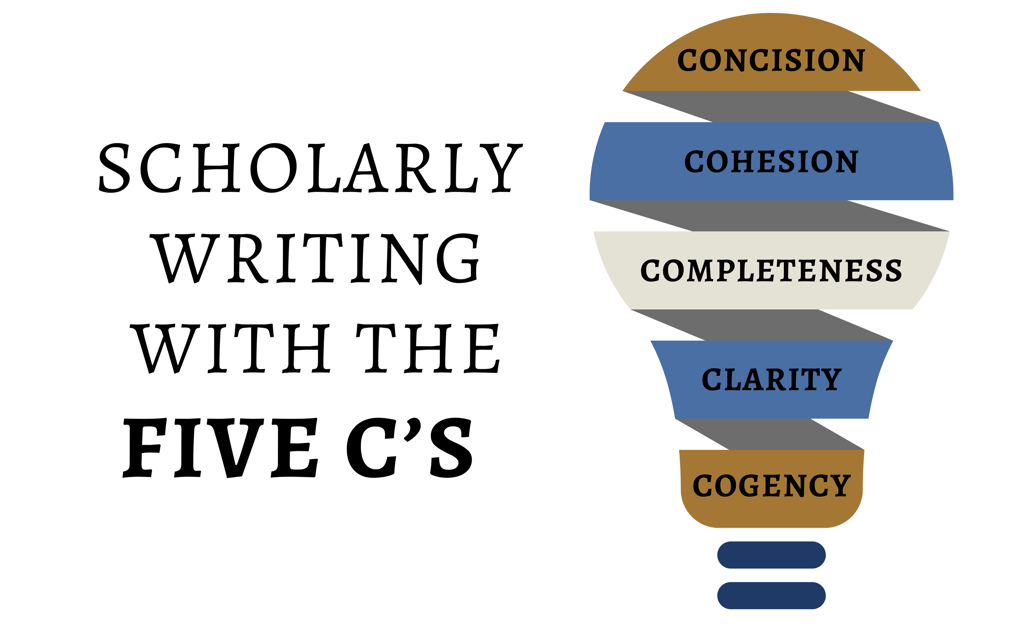Save $400 on your edit with the Preferred Client Value Package! Hurry—space is limited!
Mastering Scholarly Writing: The Five Cs for Academic Excellence
5 min read


Scholarly writing is a cornerstone of academic success, requiring precision, organization, and a keen understanding of effectively communicating ideas. Academic work demands writers engage their audience through well-structured arguments, logical flow, and meticulous attention to detail. To produce compelling work, scholars must strive for concision, cohesion, clarity, completeness, and cogency—the Five Cs of scholarly writing. Each principle plays a vital role in ensuring that your ideas are presented effectively, allowing readers to focus on the content rather than struggling with the form. Additionally, choosing between active and passive voice can significantly impact the tone and readability of your work, helping to convey authority and professionalism. This article will help you master these key principles to elevate the quality and impact of your academic writing.


Concision: Say More with Less
Concision is about delivering your message in the fewest words possible without sacrificing meaning or clarity. In scholarly writing, overly verbose sentences can obscure your ideas, create unnecessary complexity, and frustrate your readers. By focusing on brevity and precision, you ensure that your arguments are easy to follow and retain their impact. Aim to eliminate redundancy, avoid filler words, and prioritize precise language. Review your sentences critically to identify areas where phrasing can be tightened or simplified without losing essential details.
Tips for Writing Concisely
Avoid Redundancy: Replace phrases like “combine together” with “combine” or “a total of” with “total.”
Use Strong Verbs: Choose specific verbs that convey your meaning without needing modifiers (e.g., "analyzed" instead of "performed an analysis").
Simplify Phrasing: Replace long expressions with shorter equivalents (e.g., "due to the fact that" becomes "because").
Example:
Wordy: "The results of the study clearly demonstrate that the hypothesis is correct."
Concise: "The study confirms the hypothesis."
Cohesion: Link Ideas Effectively
Cohesion ensures that your ideas flow logically and are connected in a way that is easy to follow. A cohesive text uses transitions and clear relationships between sentences and paragraphs to guide the reader through your argument. Effective cohesion allows readers to understand how individual points contribute to the overall narrative or thesis. It also ensures that no ideas feel isolated or disconnected, creating a seamless reading experience that enhances comprehension and engagement.
Techniques for Cohesion
Use Transitions: Employ words and phrases like “however,” “in addition,” and “therefore” to connect ideas.
Repeat Key Terms: Reiterate important concepts to maintain focus.
Ensure Paragraph Unity: Start each paragraph with a topic sentence that introduces the main idea, and ensure all subsequent sentences support it.
Example:
Less Cohesive: "Researchers studied the phenomenon. The results were surprising. There were implications for future research."
More Cohesive: "Researchers studied the phenomenon, and their results were surprising. These findings have significant implications for future research."
Clarity: Make Every Word Count
Clarity is critical in scholarly writing. Your audience should be able to understand your arguments without needing to reread sentences. Clear writing involves straightforward language, precise terminology, and well-defined concepts. When clarity is prioritized, your work becomes more accessible and impactful, ensuring your ideas are communicated effectively. Use specific examples to illustrate complex points, structure your arguments logically, and minimize jargon to avoid alienating readers who may not be familiar with technical terms. Additionally, thoroughly revising and proofreading your work can help eliminate ambiguities and enhance clarity.
Strategies for Writing Clearly
Define Key Terms: Introduce and explain specialized terms when they first appear.
Avoid Ambiguity: Ensure that pronouns (e.g., “it,” “this”) have clear antecedents.
Structure Sentences Well: Use a subject-verb-object structure to enhance readability.
Example:
Unclear: "This variable was influenced by several factors, which impacted the outcome."
Clear: "The outcome was influenced by several factors, including environmental conditions and participant behavior."
Completeness: Provide Enough Information
Completeness ensures that your writing answers all relevant questions, resolves potential ambiguities, and addresses gaps in the narrative. A complete argument anticipates the audience's needs by providing thorough context, ample evidence, and logical reasoning to support claims. This involves presenting the main points and preemptively addressing potential counterarguments or alternate perspectives. Ensuring all necessary information is included makes your work more robust, credible, and persuasive.
Guidelines for Completeness
Provide Context: Briefly summarize the background information necessary to understand your argument.
Support Claims: Use evidence, such as data, citations, or examples, to substantiate your points.
Anticipate Questions: Address potential counterarguments or gaps in your explanation.
Example:
Incomplete: "The experiment yielded significant results."
Complete: "The experiment yielded significant results, with a 25% increase in efficiency compared to the control group."
Cogency: Present Persuasive Arguments
Cogency reflects the strength and persuasiveness of your arguments. To write cogently, your reasoning must be logical, well-structured, and evidence-supported. Cogent writing involves presenting ideas in a way that is not only clear but also compelling, guiding your reader to accept your conclusions through a logical progression of claims and evidence. Additionally, addressing potential counterarguments and incorporating diverse perspectives can strengthen the persuasiveness of your work, ensuring your arguments are robust and well-rounded.
Keys to Cogent Writing
Structure Arguments Logically: Use a clear progression from claim to evidence to conclusion.
Use Credible Sources: Cite reputable, peer-reviewed studies to bolster your claims.
Avoid Logical Fallacies: Ensure your reasoning is sound and free from errors such as overgeneralization or circular reasoning.
Example:
Less Cogent: "This approach is better because it works well."
More Cogent: "This approach is more effective because it reduces error rates by 15%, as demonstrated in Smith’s (2023) study."
Active vs. Passive Voice in Scholarly Writing
Active and passive voices have a place in scholarly writing, but understanding their proper application is essential for clarity, precision, and emphasis. The choice between the two can affect how your ideas are perceived, emphasizing either the actor or the action itself. By learning when and how to use active and passive voice effectively, you can tailor your writing to suit the purpose and audience of your scholarly work.
Active Voice
In active voice, the subject performs the action clearly and directly, making the sentence more dynamic and easier to understand. Active voice emphasizes the doer of the action, which is particularly useful in academic writing when the focus is on the researcher or the process being described.
Example: "The researcher conducted the experiment."
Advantages: Direct, concise, and easier to read.
Passive Voice
In passive voice, the subject receives the action, shifting the focus from the actor to the action or outcome itself. This structure is often used in scholarly writing to emphasize results or processes, particularly when the actor is irrelevant or unknown. Passive constructions can be beneficial in scientific and technical writing where the outcome takes precedence over who performed the action.
Example: "The experiment was conducted by the researcher."
Advantages: Useful when the focus is on the action or result rather than the actor.
When to Use Active vs. Passive Voice
Active Voice: Use it to emphasize the actor or subject performing the action. Active voice makes writing more dynamic, engaging, and easier to follow. It is particularly effective when clarity and reader engagement are priorities, removing ambiguity about who or what is responsible for the action. Active voice can also help streamline sentences, making them more concise and impactful.
Passive Voice: Use passive voice when the actor is unknown, irrelevant, or deliberately deemphasized to highlight the action or outcome. Passive voice is particularly valuable in academic writing to maintain an objective tone or describe processes where the result carries more significance than the entity performing the action. By focusing on the action, the passive voice ensures that key findings or procedures are emphasized, which can enhance the clarity and neutrality of your writing.
Tip: Favor active voice for most of your writing, as it tends to be more concise and engaging.
Final Thoughts
Mastering the Five Cs—concision, cohesion, clarity, completeness, and cogency—will significantly enhance your scholarly writing. By incorporating these principles and carefully considering your use of active versus passive voice, you can craft academic work that is compelling, precise, and impactful. Remember, the key to scholarly writing is balancing depth with readability while presenting your ideas in the most effective way possible.
If you need expert guidance to refine your scholarly writing, we offer professional editing services tailored to your academic needs. Whether you’re drafting a research paper, thesis, or dissertation, we’re here to help you succeed.
Ready for a FREE Estimate?
Contact us today to discuss your project and get a personalized quote. We’re here to help you succeed!
Professional editing services for dissertations and theses.
© 2025 Preferred Edits LLC. All rights reserved.
